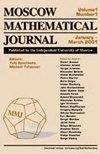Continuum Kac–Moody Algebras
IF 0.5
4区 数学
Q3 MATHEMATICS
引用次数: 4
Abstract
We introduce a new class of infinite-dimensional Lie algebras, which arise as continuum colimits of Borcherds-Kac-Moody algebras. They are associated with a topological generalization of the notion of quiver, where vertices are replaced by intervals in a real one-dimensional topological space, and are described by a continuum root system with no simple root. For these Lie algebras, we prove an analogue of the Gabber-Kac-Serre theorem, providing a complete set of defining relations featuring only quadratic Serre relations.连续统Kac-Moody代数
我们引入了一类新的无限维李代数,它们是Borcherds-Kac-Moody代数的连续界。它们与颤振概念的拓扑推广有关,其中顶点由实一维拓扑空间中的区间代替,并由无单根的连续根系统描述。对于这些李代数,我们证明了Gabber-Kac-Serre定理的一个类似,给出了一组仅以二次Serre关系为特征的定义关系。
本文章由计算机程序翻译,如有差异,请以英文原文为准。
求助全文
约1分钟内获得全文
求助全文
来源期刊
CiteScore
1.40
自引率
0.00%
发文量
16
审稿时长
>12 weeks
期刊介绍:
The Moscow Mathematical Journal (MMJ) is an international quarterly published (paper and electronic) by the Independent University of Moscow and the department of mathematics of the Higher School of Economics, and distributed by the American Mathematical Society. MMJ presents highest quality research and research-expository papers in mathematics from all over the world. Its purpose is to bring together different branches of our science and to achieve the broadest possible outlook on mathematics, characteristic of the Moscow mathematical school in general and of the Independent University of Moscow in particular.
An important specific trait of the journal is that it especially encourages research-expository papers, which must contain new important results and include detailed introductions, placing the achievements in the context of other studies and explaining the motivation behind the research. The aim is to make the articles — at least the formulation of the main results and their significance — understandable to a wide mathematical audience rather than to a narrow class of specialists.

 求助内容:
求助内容: 应助结果提醒方式:
应助结果提醒方式:


